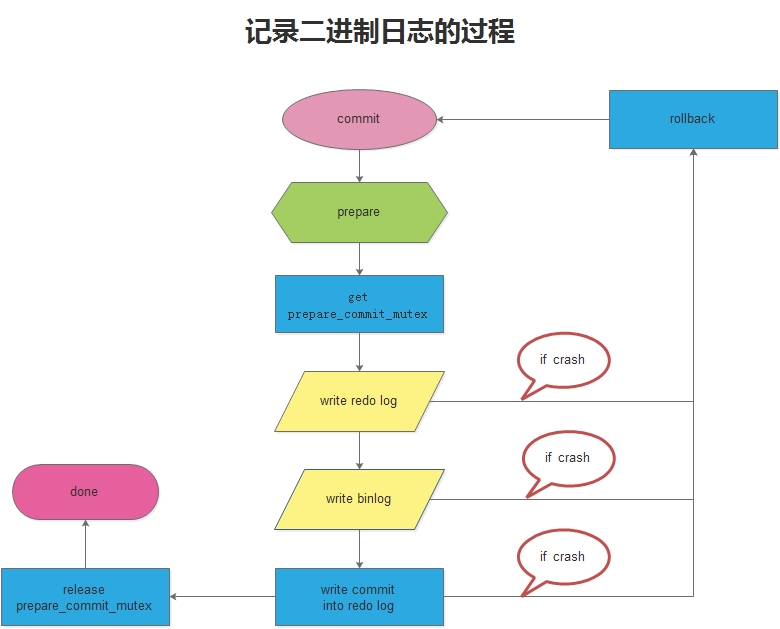mysql学习------二进制日志
一.什么是二进制日志
1.记录对数据发生或潜在发生更改的sql语句
2.二进制格式保存
3.用途广泛,包括
a.查看数据库变更历史
b.数据库增量备份
c.数据库灾难恢复
d.mysql replication
二.不重启修改二进制日志配置
1.set @@global.log_bin=1;
2.set @@global.binlog_size=37268 (单位是bytes)
3.其他参数通过以下命令查阅
show variables like '%bin%';
三.常用二进制日志相关参数
修改以下配置后,需要重启数据库服务使其生效
1.log-bin=
开启并指定二进制日志的保存路径及文件名,不设置则使用默认值,默认存放位置为数据库文件所在目录下,名称为hostname-bin.xxxx
2.max-binlog-size=500m
设置单个二进制日志文件的最大值,默认为1G,最大也为1G
3.binlog-do-db与binlog-ignore-db
指定二进制日志文件记录那些数据库操作,不记录那些数据库操作
4.binlog-cache-size=100m
设置二进制日志缓存大小
5.sync-binlog=N
每隔N秒将缓存中的二进制日志记录写回硬盘,默认为0,不过,你经常会陷入group commit函数与I/O之间的二选一矛盾,如果在replication环境中,由于考虑到耐久性及一致性,则需设置为1,同时还需要设置innodb-flush-log-at-trx-commit=1 及 innodb-support-xa=1(默认已开启)

三.二进制的操作及总结
1.暂停二进制日志
set sql_log_bin = {0|1}
2.查看二进制日志
mysqlbinlog master-bin.000001
mysqlbinlog -v master-bin.000001
mysqlbinlog -v master-bin.000001 > test.sql #导出二进制日志到sql脚本
mysqlbinlog -v master-bin.000001 >> test.sql #追加二进制日志到sql脚本
3.mysqlbinlog的命令参数
Usage: mysqlbinlog [options] log-files -?, --help Display this help and exit. --base64-output=name Determine when the output statements should be base64-encoded BINLOG statements: 'never' disables it and works only for binlogs without row-based events; 'decode-rows' decodes row events into commented pseudo-SQL statements if the --verbose option is also given; 'auto' prints base64 only when necessary (i.e., for row-based events and format description events). If no --base64-output[=name] option is given at all, the default is 'auto'. --bind-address=name IP address to bind to. --character-sets-dir=name Directory for character set files. -d, --database=name List entries for just this database (local log only). --debug-check Check memory and open file usage at exit . --debug-info Print some debug info at exit. --default-auth=name Default authentication client-side plugin to use. -D, --disable-log-bin Disable binary log. This is useful, if you enabled --to-last-log and are sending the output to the same MySQL server. This way you could avoid an endless loop. You would also like to use it when restoring after a crash to avoid duplication of the statements you already have. NOTE: you will need a SUPER privilege to use this option. -F, --force-if-open Force if binlog was not closed properly. (Defaults to on; use --skip-force-if-open to disable.) -f, --force-read Force reading unknown binlog events. -H, --hexdump Augment output with hexadecimal and ASCII event dump. -h, --host=name Get the binlog from server. -l, --local-load=name Prepare local temporary files for LOAD DATA INFILE in the specified directory. -o, --offset=# Skip the first N entries. -p, --password[=name] Password to connect to remote server. --plugin-dir=name Directory for client-side plugins. -P, --port=# Port number to use for connection or 0 for default to, in order of preference, my.cnf, $MYSQL_TCP_PORT, /etc/services, built-in default (3306). --protocol=name The protocol to use for connection (tcp, socket, pipe, memory). -R, --read-from-remote-server Read binary logs from a MySQL server. This is an alias for read-from-remote-master=BINLOG-DUMP-NON-GTIDS. --read-from-remote-master=name Read binary logs from a MySQL server through the COM_BINLOG_DUMP or COM_BINLOG_DUMP_GTID commands by setting the option to either BINLOG-DUMP-NON-GTIDS or BINLOG-DUMP-GTIDS, respectively. If --read-from-remote-master=BINLOG-DUMP-GTIDS is combined with --exclude-gtids, transactions can be filtered out on the master avoiding unnecessary network traffic. --raw Requires -R. Output raw binlog data instead of SQL statements, output is to log files. -r, --result-file=name Direct output to a given file. With --raw this is a prefix for the file names. --secure-auth Refuse client connecting to server if it uses old (pre-4.1.1) protocol. (Defaults to on; use --skip-secure-auth to disable.) --server-id=# Extract only binlog entries created by the server having the given id. --server-id-bits=# Set number of significant bits in server-id --set-charset=name Add 'SET NAMES character_set' to the output. -s, --short-form Just show regular queries: no extra info and no row-based events. This is for testing only, and should not be used in production systems. If you want to suppress base64-output, consider using --base64-output=never instead. -S, --socket=name The socket file to use for connection. --start-datetime=name Start reading the binlog at first event having a datetime equal or posterior to the argument; the argument must be a date and time in the local time zone, in any format accepted by the MySQL server for DATETIME and TIMESTAMP types, for example: 2004-12-25 11:25:56 (you should probably use quotes for your shell to set it properly). -j, --start-position=# Start reading the binlog at position N. Applies to the first binlog passed on the command line. --stop-datetime=name Stop reading the binlog at first event having a datetime equal or posterior to the argument; the argument must be a date and time in the local time zone, in any format accepted by the MySQL server for DATETIME and TIMESTAMP types, for example: 2004-12-25 11:25:56 (you should probably use quotes for your shell to set it properly). --stop-never Wait for more data from the server instead of stopping at the end of the last log. Implicitly sets --to-last-log but instead of stopping at the end of the last log it continues to wait till the server disconnects. --stop-never-slave-server-id=# The slave server_id used for --read-from-remote-server --stop-never. --stop-position=# Stop reading the binlog at position N. Applies to the last binlog passed on the command line. -t, --to-last-log Requires -R. Will not stop at the end of the requested binlog but rather continue printing until the end of the last binlog of the MySQL server. If you send the output to the same MySQL server, that may lead to an endless loop. -u, --user=name Connect to the remote server as username. -v, --verbose Reconstruct pseudo-SQL statements out of row events. -v -v adds comments on column data types. -V, --version Print version and exit. --open-files-limit=# Used to reserve file descriptors for use by this program. -c, --verify-binlog-checksum Verify checksum binlog events. --binlog-row-event-max-size=# The maximum size of a row-based binary log event in bytes. Rows will be grouped into events smaller than this size if possible. This value must be a multiple of 256. --skip-gtids Do not print Global Transaction Identifier information (SET GTID_NEXT=... etc). --include-gtids=name Print events whose Global Transaction Identifiers were provided. --exclude-gtids=name Print all events but those whose Global Transaction Identifiers were provided.
4.删除二进制日志
a.二进制日志会不断的增长,并产生多个文件,因此需要制定备份计划和管理策略,无用的二进制日志要记得及时删除
b.删除二进制日志有三种方法:
1.操作系统命令直接删除
2.reset master
3.purge
purge {master | binary} logs to 'log_name'
purge {master | binary} logs before 'date'
5.总结
a.日志影响mysql的性能有大量的磁盘空间,因此,往往做采样分析时才打开
b.即使做采样分析,也最好仅在一台测试机器上开启
c.二进制日志由于用途广泛,大多数情况下会开启,需要制定合理的备份计划和管理策略
转载于:https://www.cnblogs.com/Yongzhouunknown/p/4865762.html
- MySQL中二进制与重做日志文件的基本概念学习教程
- MySQl Study学习之--MySQl二进制日志管理
- Mysql学习第三课-分析二进制日志进行增量备份和还原
- mysql dba系统学习(5)二进制日志binlog之一
- mysql dba系统学习(6)二进制日志binlog之二
- mysql dba系统学习(5)二进制日志之一
- MYSQL语句+索引+忘记密码+解决乱码+二进制日志 -学习笔记
- MySQl Study学习之--MySQl二进制日志管理
- mysql dba系统学习(6)二进制日志binlog之二
- mysql学习总结(二进制日志、服务器变量、事务日志)
- MySQl Study学习之--MySQl二进制日志管理
- MySQl Study学习之--MySQl二进制日志管理
- Mysql学习之--Mysql二进制日志管理
- mysql dba系统学习(7)二进制日志之三
- mysql dba系统学习(6)二进制日志之二
- mysqlbinlog- 处理二进制日志文件的实用工具 学习笔记
- MySql的二进制日志,重做日志笔记,UndoLog
- mysql二进制日志设置
- 跟我一起学习mysql技术内幕(第五版)吧!(学习日志)
- 安全删除 mysql-bin 二进制日志
